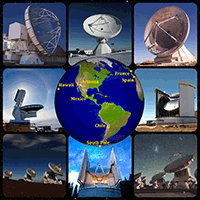 Credit: APEX, IRAM, G. Narayanan,
Credit: APEX, IRAM, G. Narayanan,J. McMahon, JCMT/JAC, S. Hostler, D. Harvey,
ESO/C. Malin
Click here for larger view.
EHT Collaboration Meeting 2016
Meeting Dates:
November 29 - December 2, 2016
Location:
The meeting and all presentations will be in the AC Hotel at
10 Acorn Park Drive, Cambridge, Massachusetts USA
Additional information available here!
UPDATE: This is a collaboration meeting for EHT Consortium participants. Please get in touch with the organizers if you want to attend but did not receive an invitation and are not associated with an EHT stakeholder institution.
The Event Horizon Telescope is the first astronomical instrument capable of imaging the horizon of a known black hole. By assembling a global network of existing millimeter and sub-millimeter wavelength observatories, the EHT can access the extraordinary resolutions required via Very Long Baseline Interferometry. Already it has detected horizon scale structure around the supermassive black holes at the centre of the Milky Way and the giant elliptical galaxy M87.
It is an exciting time in the project with first observations that include the ALMA array scheduled for April 2017, and the prospects for horizon-resolving science more promising than ever. This collaboration meeting (EHT 2016) will be an opportunity to review EHT science goals, theoretical advances, data analysis, technical developments, observing strategies, and project organization.
This is the third in a meeting series designed to bring together the full EHT community, from instrument builders to theoretical modelers, for the purpose of fully exploiting the unique opportunities that the EHT provides. Past EHT meetings have followed a traditional format of talks by EHT scientists as well as experts from a diverse set of fields. For EHT 2016 - with critical observations and organizational efforts underway - the meeting structure will include a strong component of science, but shift in focus to the collaboration itself: the collaborative structure, working groups (both technical and scientific) and the logistics and preparations for the upcoming observations in 2017.
The main goals of the Collaboration Meeting:
The Event Horizon Telescope is the first astronomical instrument capable of imaging the horizon of a known black hole. By assembling a global network of existing millimeter and sub-millimeter wavelength observatories, the EHT can access the extraordinary resolutions required via Very Long Baseline Interferometry. Already it has detected horizon scale structure around the supermassive black holes at the centre of the Milky Way and the giant elliptical galaxy M87.
It is an exciting time in the project with first observations that include the ALMA array scheduled for April 2017, and the prospects for horizon-resolving science more promising than ever. This collaboration meeting (EHT 2016) will be an opportunity to review EHT science goals, theoretical advances, data analysis, technical developments, observing strategies, and project organization.
This is the third in a meeting series designed to bring together the full EHT community, from instrument builders to theoretical modelers, for the purpose of fully exploiting the unique opportunities that the EHT provides. Past EHT meetings have followed a traditional format of talks by EHT scientists as well as experts from a diverse set of fields. For EHT 2016 - with critical observations and organizational efforts underway - the meeting structure will include a strong component of science, but shift in focus to the collaboration itself: the collaborative structure, working groups (both technical and scientific) and the logistics and preparations for the upcoming observations in 2017.
The main goals of the Collaboration Meeting:
- Describe the broad scientific context of astrophysical black holes and its relationship to EHT observations, including developments in our understanding of the astrophysics of the initial EHT targets: the supermassive black holes at the centre of the Milky Way (Sgr A*) and M87.
- Present new EHT-driven results.
- Host breakout sessions where focused working groups can plan and make progress on critical aspects of the EHT including: technical developments, deployment of instrumentation and testing, logistics for observations, data processing, and analysis techniques.
- Discuss the EHT collaboration and organize the EHT community.

